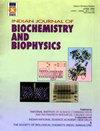Newly-discovered behaviour in the bacterial histone-like protein, HU
IF 1.5
4区 生物学
Q4 BIOCHEMISTRY & MOLECULAR BIOLOGY
引用次数: 0
Abstract
This paper summarizes the contents of a talk delivered at the MS University of Baroda (Vadodara, Gujarat) on 3rd March, 2023, at a conference held to celebrate proteins in commemoration of the birth centenary of Prof. G. N. Ramachandran. Here, we review several recent discoveries and applications from our group that relate to HU, a DNA-binding nucleoid-associated protein found in bacteria: (1) HU uses its DNA-binding sites to bind to lipopolysaccharide (LPS) upon bacterial cell surfaces, in the extracellular milieu in biofilms, thus working as a glue to attach bacteria to extracellular DNA; (2) HU and DNA perform mutual macromolecular crowding, as well as mutual charge neutralization, to together undergo condensation into nucleoids that appear to maintain DNA in a compacted state in bacterial genomes through liquid-liquid phase separation (LLPS); (3) HU appears to have evolved to avoid use of the amino acid residue, tryptophan, to avoid damage to bacterial genomic DNA by a combination of sunlight and photosensitized oxidation by tryptophan photodecomposition products; (4) HU’s N-terminal (positive) charge destabilizes hydrophobic inter-subunit interactions between beta strands in HU dimers and promotes subunit exchange between HU-A and HU-B (the two isoforms of HU in gut bacteria), thus hindering the facile dissociation of subunits if an N-terminal 6xHis affinity tag is present; (5) HU-A and HU-B can be genetically fused to generate a simulacrum of an HU heterodimer; (6) HU’s DNA-binding regions from two bacterial homologs (one mesophilic and the other thermophilic) can be isolated and genetically fused to generate a novel thermostable DNA-binding protein; (7) HU’s ability to titrate onto the bacterium’s nucleoid can be exploited to deploy fluorescent protein-labelled HU in cells to test for leaky expression from bacterial promoters, using fluorescence microscopy.细菌组蛋白样蛋白HU的新发现行为
本文总结了2023年3月3日在MS University of Baroda (Vadodara, Gujarat)举行的纪念G. N. Ramachandran教授诞辰100周年的蛋白质庆祝会议上的演讲内容。在这里,我们回顾了我们小组最近发现的与细菌中发现的DNA结合核相关蛋白HU相关的几个发现和应用:(1)HU利用其DNA结合位点与细菌细胞表面的脂多糖(LPS)结合,在生物膜的细胞外环境中,从而作为胶水将细菌附着在细胞外DNA上;(2) HU和DNA通过液-液相分离(LLPS)进行相互的大分子拥挤,以及相互的电荷中和,共同缩聚成类核,使细菌基因组中的DNA保持紧致状态;(3) HU似乎已经进化到避免使用氨基酸残基色氨酸,以避免阳光和色氨酸光分解产物的光敏氧化对细菌基因组DNA的损害;(4) HU的n端(正电荷)使HU二聚体中β链之间的疏水亚基相互作用不稳定,并促进HU- a和HU- b(肠道细菌中HU的两种亚型)之间的亚基交换,从而在存在n端6xHis亲和标签时阻碍亚基的容易解离;(5) HU- a和HU- b可以遗传融合产生HU异源二聚体的模拟物;(6) HU的dna结合区可以从两种细菌同系物(一种是嗜中温菌,另一种是嗜热菌)中分离出来并进行遗传融合,从而产生一种新的耐热性dna结合蛋白;(7) HU滴定到细菌的类核上的能力可以利用荧光显微镜在细胞中部署荧光蛋白标记的HU来检测细菌启动子的泄漏表达。
本文章由计算机程序翻译,如有差异,请以英文原文为准。
求助全文
约1分钟内获得全文
求助全文
来源期刊

Indian journal of biochemistry & biophysics
生物-生化与分子生物学
CiteScore
2.90
自引率
50.00%
发文量
88
审稿时长
3 months
期刊介绍:
Started in 1964, this journal publishes original research articles in the following areas: structure-function relationships of biomolecules; biomolecular recognition, protein-protein and protein-DNA interactions; gene-cloning, genetic engineering, genome analysis, gene targeting, gene expression, vectors, gene therapy; drug targeting, drug design; molecular basis of genetic diseases; conformational studies, computer simulation, novel DNA structures and their biological implications, protein folding; enzymes structure, catalytic mechanisms, regulation; membrane biochemistry, transport, ion channels, signal transduction, cell-cell communication, glycobiology; receptors, antigen-antibody binding, neurochemistry, ageing, apoptosis, cell cycle control; hormones, growth factors; oncogenes, host-virus interactions, viral assembly and structure; intermediary metabolism, molecular basis of disease processes, vitamins, coenzymes, carrier proteins, toxicology; plant and microbial biochemistry; surface forces, micelles and microemulsions, colloids, electrical phenomena, etc. in biological systems. Solicited peer reviewed articles on contemporary Themes and Methods in Biochemistry and Biophysics form an important feature of IJBB.
Review articles on a current topic in the above fields are also considered. They must dwell more on research work done during the last couple of years in the field and authors should integrate their own work with that of others with acumen and authenticity, mere compilation of references by a third party is discouraged. While IJBB strongly promotes innovative novel research works for publication as full length papers, it also considers research data emanating from limited objectives, and extension of ongoing experimental works as ‘Notes’. IJBB follows “Double Blind Review process” where author names, affiliations and other correspondence details are removed to ensure fare evaluation. At the same time, reviewer names are not disclosed to authors.
 求助内容:
求助内容: 应助结果提醒方式:
应助结果提醒方式:


